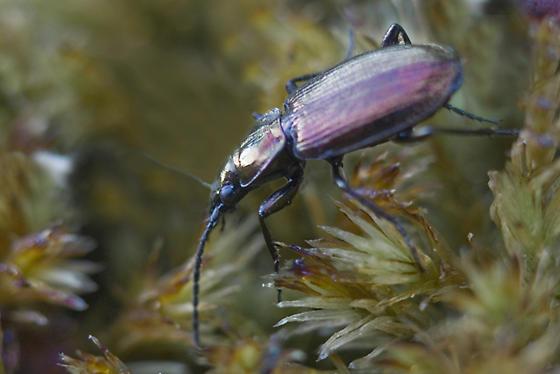Moderate-
High
In Washington, the Beller's ground beetle is designated as a "Species of Greatest Conservation Need" due to their small number of isolated populations, highly limited distribution and range, and dependence on specialized, restricted and threatened habitats.
Description and Range
Physical description
The Beller's ground beetle is in the family Carabidae and subfamily Carabinae.
Ecology and life history
The Beller's ground beetle is a habitat specialist. This species occurs only in low to mid-elevation (less than 3280 feet) Puget Trough Sphagnum bogs; unique, peat-forming wetlands with vegetation dominated by Sphagnum genus mosses.
Sphagnum bogs are typically small in size and situated in closed depressions within small watersheds, and thus are geographically isolated. An ancient habitat, today bogs persist in relict patches that thousands of years ago were part of more broadly occurring muskeg-like vegetation. Sphagnum bogs make up only three percent of the wetlands in western Washington.
Carabids undergo complete metamorphosis, which means they have egg, larval, pupal, and adult life stages. These beetles typically reproduce annually; adults can live for several years, and larvae may require multiple years for complete development.
Females create shallow burrows in the soil with their ovipositor, where they lay eggs singly; larvae feed and develop, pupation occurs, and adults emerge from these tunnel-like burrows. Thus, soil condition, including texture, moisture, and temperature is a vital element of habitat quality.
Carabids are key predators of the insect world; as both larvae and adults they feed on other insects and, to a lesser extent, plant material. Adults hunt by sight and are fast runners that can quickly subdue their prey. Beller's ground beetle adults generally forage during the day, and at night burrow into soil, sand, or other substrate.
Beller’s ground beetle are flightless species with highly limited dispersal capability. These beetles inhabit their sites year-round (as egg, larva, pupa and adult).
Geographic range
In Washington, the overall range of the Beller's ground beetle is disjunct populations occurring in Queen Charlotte Islands and southwest British Columbia, Canada; Puget Sound lowlands in Washington (King, Kitsap, Mason, Skagit, Snohomish and Thurston counties); and northwest Oregon.
Carabid beetles have restricted ranges and distributions within Washington. Distribution is limited in part by a combination of their dependence on restricted ecological niches, and those niches’ location within rare habitat types. Their distribution and abundance is characterized by small numbers of isolated populations.
For a map showing range-wide conservation status and distribution of this species, check out NatureServe Explorer.
Climate vulnerability
Sensitivity to climate change
Moderate
Beller's ground beetles inhabit sphagnum bogs or sphagnum moss in other wet areas (e.g., near springs), preferring the wettest sites available. This species' sensitivity to climate change will largely be driven by shifts in habitat availability. Reduced water availability and quality (i.e., due to precipitation shifts, reduced snowpack, earlier snowmelt) can affect bog water levels, seasonal bog duration, and rates of succession to meadow or other adjacent vegetation, potentially reducing or degrading habitat for this beetle. This species is likely sensitive to both bog drying and prolonged inundation from flooding. Without flight capabilities, this species has limited ability to move in response to climate change (i.e., refugia would have to be contiguous and accessible by ground). Warmer temperatures may increase beetle activity; Beller's ground beetles have historically been found in highest numbers during hot periods.
Exposure to climate change
Moderate-
High
- Changes in precipitation (snow and rain)
- Increased amount and/or duration of flooding
- Drought
Conservation
Conservation Threats and Actions Needed
- Fish and wildlife habitat loss or degradation
- Threat: Bog/fen obligate; habitat and species are vulnerable to alteration of local hydrology from development.
- Action Needed: Designation of sites as having unique and important value to fish and wildlife.
- Agriculture and aquaculture side effects
- Threat: Bog/fen obligate; habitat and species are vulnerable to alteration of local hydrology from logging and road building.
- Action Needed: Leading or participating in land use planning for rural, urban, and forestry lands.
- Resource information collection needs
- Threat: Knowledge of current distribution is incomplete.
- Action Needed: Baseline survey and inventory to understand distribution of fish and wildlife populations.
See the Climate vulnerability section for information about the threats posed by climate change to this species.
Resources
References
Bergdahl, J. 1997. Endemic Sphagnum-bog beetles from the Puget Sound Region: Kings Lake and Snoqualmie Bogs, King County, Washington. Northwest Biodiversity Center, Seattle, Washington.
Blackburn, M. 2012. Surveys to determine the status of rare Beller’s ground beetle (Agonum belleri) and Hatch’s click beetle (Eanus hatchii) in suitable bog habitats on FS lands in the Mt. Baker-Snoqualmie and Okanogan-Wenatchee National Forests of Washington. Project completion report to the Interagency Special Status/Sensitive Species Program (ISSSP), US Bureau of Land Management and US Forest Service. 26pp.
US Forest Service and Bureau of Land Management (USFS-BLM). 2009. Species fact sheet: Beller’s ground beetle. Prepared by The Xerces Society for Invertebrate Conservation. Portland, Oregon.
